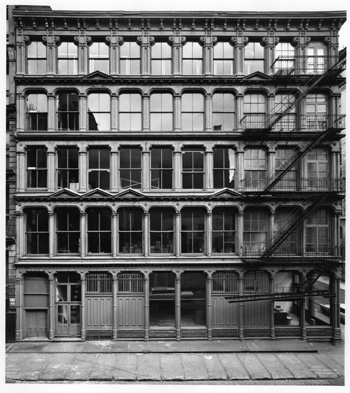
101 Spring Street, site of Judd's former home and studio. Photo by Paul Katz. Courtesy Judd Foundation Archives.
For the second time in its history, the Judd Foundation will open Donald Judd’s New York home and studio to the public. Currently, the five-story SoHo space is undergoing renovations in preparation for a spring 2013 grand opening. That’s less than a year away. It remains unclear what the building will become, and how much of the artist’s personal collection will be on view.
“It’s not a museum,” said Christopher Longfellow, Program Officer at the Judd Foundation, [told us] “We’re not Chinati.” The Chinati Foundation, a museum founded by Judd in Marfa, Texas, already fulfills the role of a museum with a large collection of Judd works.
Museum or not, the artist’s space at 101 Spring Street will emerge from its restoration with a new, public role. The Judd Foundation plans to integrate scheduled tours at Judd’s New York studio and home, just like they do with Judd’s homes and studios in Marfa. When I asked Longfellow what kind of public programs the foundation will end up hosting in the New York space, he told me those were still in the works.
What we do know, is that visitors will be able to view the artist’s home as he left it, along with his personal art collection. At Judd’s bequest, the foundation was gifted 1,000 household objects, artworks, and furnishings, installed at 101 Spring Street. These works consist of both the artist’s purchases and works made by the artist himself. The Judd Foundation’s assets—$315,061,070 according to the latest financial statements—are a testament of the nonprofit’s impressive holdings in art and real estate. And the bulk of these works were made by Judd; the foundation has an exclusive agreement with David Zwirner to sell works by the Minimalist.
In the upcoming months, the Judd Foundation plans to release more details regarding the opening of Judd’s New York home and studio. We’re waiting to see what works from Judd’s personal collection will be on display and what type of programs the foundation will roll out. Until then, there’s always Marfa.


{ 3 comments }
having toured the building several years ago, i don’t know if it’s really the “first time in history” that the space has been open to the public. at least five years ago, i simply emailed the foundation and asked for a tour, gave a small donation, and was shown the entire building. so…i understand that maybe tours will be more frequent and/or scheduled, or perhaps there will just be more publicity surrounding the building and its contents, but yeah, the other details (the living spaces as he left them, judd’s work and other artworks from his personal collection) were in place just as you mention here. i wasn’t on an official research visit, part of a press tour, or attending a special event when i visited spring street. it was me, my partner, and a guide. $10 each. maybe i caught someone on the right day or maybe my experience was atypical, but there you go.
It’s the “public” part that’s tricky when it comes to non-profits. If something’s “by appointment only,” then it’s not considered public for non-profit purposes.
That’s right. Among other things, there’s a Carl Andre stack of a few bricks on the wooden planks of the ground floor, and upstairs in the bedroom there’s a huge row of Dan Flavin light squares along one window wall, and a Lucas Samaras prickly box by the mattress on the floor. The his and hers basic bathrooms are terrific, as are the sleeping quarters for the kids. The open kitchen is impressive, too. It’s like stepping back into the Soho art world of yore and seeing how a now historically significant artist lived and entertained. Like many historic houses, admission is only as part of a group, and I imagine that will stay the same. – Jason Kaufman
Comments on this entry are closed.